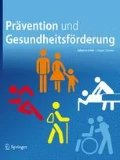Zusammenfassung
Hintergrund
Im Rahmen von „IN FORM – Deutschlands Initiative für gesunde Ernährung und mehr Bewegung“ wurden seit 2008 zahlreiche Impulse im Bereich der Bewegungsförderung gesetzt. Das Feld gilt dennoch, nicht zuletzt wegen der Vielfalt der Akteure und Handlungsfelder, als heterogen.
Fragestellung
Es galt festzustellen, inwieweit eine strukturelle Verankerung der Bewegungsförderung in unterschiedlichen Feldern gelungen ist, wo Lücken erkennbar oder Doppelspurigkeiten entstanden sind. Hierüber sollen Ansatzpunkte für die Weiterentwicklung der Bewegungsförderung entwickelt werden.
Material und Methoden
Das Projekt folgte einem mehrstufigen Prozess: 1.) leitfadengestützte Interviews mit Experten der Bewegungsförderung (n = 7) zur Einschätzung des Status quo. 2.) Fokusgruppendiskussion in der die Einschätzungen diskutiert und zu Thesen verdichtet wurden. 3.) Bewertung der Thesen (quantitativ und qualitativ) in einer zweiphasigen Delphi-Befragung von 41 Akteuren der Bewegungsförderung. Aus den Ergebnissen wurden 4.) auf einem Statusworkshop Handlungsempfehlungen abgeleitet.
Ergebnisse und Diskussion
Die Ergebnisse zeigen vielfältige Bedarfe für eine Weiterentwicklung der Strukturen für Bewegungsförderung in Deutschland auf. Eine strukturelle Verankerung muss auf mehreren Ebenen noch erfolgen bzw. verstärkt werden. Handlungsbedarf wurde gesehen bei einem weiterhin bestehenden Präventionsdilemma (v. a. gesunde Personen mit hohem sozioökonomischen Status erreicht), mangelnder Zielgruppenspezifität, vorherrschenden Einzelprojekten ohne gemeinsame Strategie, mangelnder Koordination und Vernetzung, zu geringen Stellenwert und Zuständigkeiten auf kommunaler Ebene sowie Ausbaubedarf für Bewegungsförderung in Pflege und Rehabilitation. Die abgeleiteten Empfehlungen bieten Ansatzpunkte für weitere Diskussionen, einige Fragen bleiben jedoch offen.
Abstract
Background
Since 2008, the German National Action Plan “IN FORM—German national initiative to promote healthy diet and physical activity” has offered various incentives to promote physical activity. However, the field of physical activity promotion is heterogeneous, not least because of stakeholders’ diversity.
Objectives
The objective of the current paper is to assess to which extent infrastructure for physical activity promotion has been accomplished. The knowledge about gaps and parallel structures in this field is the starting point to identify need for action and to give recommendations to improve physical activity promotion in Germany.
Materials and methods
The Delphi study followed a multistage process: 1.) expert interviews were conducted (n = 7) to assess the current situation of physical activity promotion. 2.) a focus group discussed the experts’ ratings and derived theses/statements from their descriptions that are relevant for future improvements. 3.) the statements were rated quantitatively and qualitatively within a two round Delphi study from n = 41 players of physical activity promotion. In a final step, recommendations for action were derived from the results at a workshop with the Delphi participants.
Results and discussion
The study showed a need for action to improve physical activity promotion in Germany at different levels. Areas for action are the prevention dilemma (mainly health engaged people are reached), a lack of target group specificity, predominant separate projects without a common strategy, a lack of coordination and networking, and the insufficient role and resources for physical activity promotion at the municipal level as well as in geriatric care and rehabilitation. Derived recommendations have to be discussed further and some open questions remain.



Literatur
Cavill N, Kahlmeier S, Racioppi F (2010) Physical activity and health in Europe. WHO Regional Office for Europe, Kopenhagen
Globales Komitee für Bewegung (2010) Die Toronto Charta für Bewegung: ein globaler Aufruf zum Handeln. http://www.globalpa.org.uk. Zugegriffen: 26. Februar 2016
Häder M (2014) Delphi-Befragungen. Ein Arbeitsbuch. Springer, Wiesbaden
Hallal PC, Andersen LB, Bull FC et al (2012) Global physical activity levels: surveillance progress, pitfalls, and prospects. Lancet 380:247–257
Horn A, Kleina T, Vogt D, Koch M, Schaeffer D (2013) Bewegungsfördernde Interventionen als Option für Prävention und Gesundheitsförderung in der stationären Langzeitversorgung. Ergebnisse einer Literaturrecherche. Veröffentlichungsreihe des Instituts für Pflegewissenschaft. IPW, Bielefeld
Mayring P (2010) Qualitative Inhaltsanalyse. Grundlagen und Techniken. Beltz, Weinheim
Novakowski N, Wellar B (2008) Using the Delphi technique in normative planning research: Methodological design consideration. Environ Plan A 40:1485–1500
Pettee GKK, Morrow JR, Woolsey AL (2012) Framework for physical activity as a complex and multidimensional behavior. J Phys Act Health 9(Suppl):11–18
Robert Koch-Institut (2012) Einflussfaktoren auf die Gesundheit: Körperliche Aktivität. Gesundheit in Deutschland aktuell 2010. RKI, Berlin
Sundberg CJ (2016) Physical activity: what is already being done and how we can avert 1 million deaths annually in future. Br J Sports Med 50:319
Vorgrimler D, Wübben D (2003) Die Delphi-Methode und ihre Eignung als Prognoseinstrument (Wirtschaft und Statistik Nr. 8). Statistisches Bundesamt, Wiesbaden
World Health Organization (WHO) (2010) Global recommendations on physical activity for health. WHO, Genf
WHO (2009) Global Health Risks. Mortality and burden of disease attributable to selected major risks. WHO, Genf
Wilson MG, Ellison GM, Cable NT (2016) Basic science behind the cardiovascular benefits of exercise. Br J Sports Med 50:93–99
Author information
Authors and Affiliations
Corresponding author
Ethics declarations
Interessenkonflikt
H. Gohres und P. Kolip geben an, dass kein Interessenkonflikt besteht.
Dieser Beitrag beinhaltet keine von den Autoren durchgeführten Studien an Menschen oder Tieren.
Rights and permissions
About this article
Cite this article
Gohres, H., Kolip, P. Strukturen der Bewegungsförderung in Deutschland. Präv Gesundheitsf 12, 203–210 (2017). https://doi.org/10.1007/s11553-017-0580-7
Published:
Issue Date:
DOI: https://doi.org/10.1007/s11553-017-0580-7

